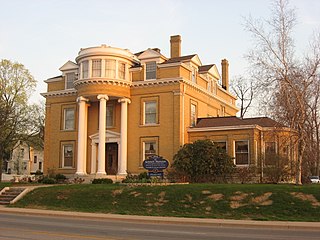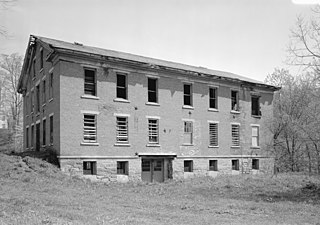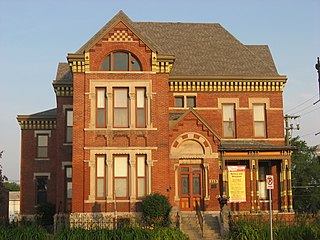
Cambridge City is a town in Jackson Township, Wayne County, in the U.S. state of Indiana. The population was 1,870 at the 2010 census.

The Starr Historic District is a neighborhood of historic buildings and national historic district located at Richmond, Wayne County, Indiana. The district encompasses 102 contributing buildings in a predominantly residential section of Richmond. It developed between about 1853 and 1915 and includes representative examples of Greek Revival, Italianate, Second Empire, and Queen Anne style architecture. Included in the district is a former Hicksite Quaker Meeting House, now the Wayne County Historical Museum and the Reid Memorial Presbyterian Church and Andrew F. Scott House. Other notable buildings include the Miller-Mendenhall House (1875), Dickinson Log House (1825), Starr-Cadwalader House (1861), and Clem Gaar House (1883).

The East Main Street–Glen Miller Park Historic District is a neighborhood of historic residential buildings and national historic district located at Richmond, Wayne County, Indiana. The district encompasses 84 contributing buildings, 11 contributing structures, and 5 contributing objects along the National Road and sometimes called Millionaire's Row. A portion of the district is recognized by the City of Richmond's Historic Preservation Commission as the Linden Hill conservation district. It developed between about 1830 and 1937 and includes representative examples of Italianate, Queen Anne, Colonial Revival, Tudor Revival, Classical Revival, and Bungalow / American Craftsman style architecture. Located in the district is the separately listed Henry and Alice Gennett House. Other notable contributing resources include elaborate iron bridges and "Madonna of the Trail" statue located in Glen Miller Park, Isham Sedgwick House (1884-1885), John A. Hasecoster House (1895), William H. Campbell House (1905), Howard Campbell House (1909), E.G. Hill House, Crain Sanitarium, and Dr. T. Henry Davis House.

The Wayne County Courthouse is a historic courthouse located in Richmond, Wayne County, Indiana. It was built during the period 1890–93, and is in the Richardsonian Romanesque style. The building was designed by Cincinnati, Ohio, architect James W. McLaughlin and the construction was supervised by New Castle, Indiana, architect William S. Kaufman. The "U"-shaped building measures approximately 214 feet by 128 feet, and is constructed of brick faced with Indiana Limestone. It features a projecting entrance pavilion, high pitched hipped and gable roofs, large semicircular arches, and octagonal corner tower. Architectural historians Michael Tomlan and Mary Raddant-Tomlan have suggested that the Wayne County Courthouse was influenced both in terms of exterior design and elements of interior layout by Henry Hobson Richardson's Allegheny County Courthouse in Pittsburgh, Pennsylvania.

The Indianapolis City Market is a historic public market located in Indianapolis, Indiana. It was founded in 1821 and officially opened in its current facility in 1886. The market building is a one-story, rectangular brick building trimmed in limestone. It has a front gable center section flanked by square towers. While it was originally a farmers market, it is now a food hall. The Indianapolis City Market also hosted some events for Super Bowl XLVI in Indianapolis.

Thomas W. Swinney House, also known as The Swinney Homestead, is a historic home located at Fort Wayne, Indiana. It was built in 1844-1845 as a 1+1⁄2-story brick and limestone structure. It was enlarged with a 2+1⁄2-story, square, Late Victorian style brick wing about 1885. It features an Eastlake movement front porch. It was built by Thomas J. Swinney, a pioneer settler of Allen County and prominent Fort Wayne businessman. The house and land for Swinney Park were passed to the city of Fort Wayne in 1922.

Yount's Woolen Mill and Boarding House is a historic woolen mill and boarding house located in Ripley Township, Montgomery County, Indiana. The boarding house was built in 1851, and is a two-story, "L"-shaped, Late Federal style brick building. It has a gable-on-hip roof and two-story porch on the rear side. The mill was built in 1864, and is a 2+1⁄2-story brick building on a raised basement with Greek Revival style design elements. Also on the property are the remains of an 1849 frame mill, an 1867 brick building, dam and mill race. The Yount Mill was contracted by the U.S. Government to manufacture Army uniforms during both the American Civil War and Spanish–American War.

Montgomery County Jail and Sheriff's Residence is a historic jail and sheriff's residence located at Crawfordsville, Montgomery County, Indiana. It was built in 1882 in two sections, and is a 2+1⁄2-story, red brick and limestone building in a combination of Italianate, Gothic Revival, and Romanesque Revival style architecture. The jail is a "rotary jail"; it is the only example of this type in Indiana and one of two left in the United States. The building houses a local history and prison museum.

Andrew F. Scott House is a historic home located at Richmond, Wayne County, Indiana. It was built in 1858, and is a two-story, cubic, Italianate style brick dwelling. It has a hipped roof topped by a cupola and kitchen wing. It features a projecting pedimented central entrance bay flanked by one-story verandahs with decorated posts. From 1977 to 2004, it was owned by the Wayne County Historical Museum and operated as a historic house museum.

Henry and Alice Gennett House, also known as The Gennett Mansion, is a historic home located at Richmond, Wayne County, Indiana. It was built in 1898, and is a large two-story, Colonial Revival style yellow ceramic brick dwelling, with small projecting porches or wings on each side. It sits on a limestone foundation and has a hipped roof. It features a two-story entrance portico with Ionic order columns surmounted by a semi-circular bay.

Bethel A.M.E. Church is a historic African Methodist Episcopal church located at Richmond, Wayne County, Indiana. The congregation was founded in 1836. The church was built in 1854, and enlarged and remodeled in the Romanesque Revival style in 1892–1894. It is a one-story, cruciform plan, brick building with a 2+1⁄2-story bell tower. The church serves as an educational, political, and cultural center for the local African-American community.

Earlham College Observatory is a historic observatory building located on the campus of Earlham College at Richmond, Wayne County, Indiana. It was built in 1861, and is a one-story, brick building with a hipped roof. It consists of a 19-foot-square central section topped by a copper dome with a removable section, and flanked by 10-foot by 19-foot sections. Beneath the revolvable dome is a 6+1⁄2-inch objective lens telescope located in the center of the main block.

Lackey-Overbeck House, also known as the Lackey-Cockefair-Overbeck-Matheis House, is a historic home located at Cambridge City, Wayne County, Indiana. It was built about 1835, and is a two-story, three bay, frame dwelling with Federal and Greek Revival style design elements. A two-story rear wing was added about 1850.

Cambridge City Historic District is a national historic district located at Cambridge City, Wayne County, Indiana. The district encompasses 572 contributing buildings and 2 contributing structures in the central business district and surrounding residential sections of Cambridge City. It developed between about 1838 and 1939 and includes representative examples of Greek Revival, Italianate, and Federal style architecture. Located in the district are the separately listed Conklin-Montgomery House and Lackey-Overbeck House. Other notable contributing buildings include the Vinton House (1849), Opera House (1876), Western Wayne Bank, Grand Theater, Knights of Pythias Building (1899), Public Library (1936), U.S. Post Office (1940), City Building (1901), Crum-Swiggett House, Old Bertsch Foundry (1853), Presbyterian Church (1858), St. Elizabeth's Roman Catholic Church (1880), and Central School (1935).

Centerville Historic District is a national historic district located at Centerville, Wayne County, Indiana. The district encompasses 115 contributing buildings in the central business district and surrounding residential sections of Centerville. It developed between about 1817 and 1873 and includes representative examples of Greek Revival, Italianate, and Federal style architecture. During this period it was county seat of Wayne County. Located in the district is the separately listed Oliver P. Morton House. Other notable contributing buildings include Morton's Row, Lantz' Row, Archway row, Tarkington Homestead, Jacob Julian House (1857), the Mansion House (1837), the Jones House, and the American House (1838–39).

Witt-Champe-Myers House is a historic home located at Dublin, Wayne County, Indiana. It was built in 1837–38, and is a two-story, Federal style painted brick detached dwelling. It features a two-story front portico with Tuscan order columns on the first story and Doric order columns on the second. Also on the property are the contributing one-room brick house (1837), small brick smokehouse, and brick spring house.

Beechwood is a historic home an farm located in Washington Township, Wayne County, Indiana. It was built in 1871, and is a two-story, Italianate style brick dwelling with a hipped roof topped by a cupola. It features a semicircular stone arched main entry surrounded by a two-story, wrought iron verandah and projecting two-story semi-hexagonal bay. Also on the property are the contributing dairy house, smokehouse, granary, barn, cow shed, and carriage house.

Richmond Gas Company Building was a historic commercial building located at Richmond, Wayne County, Indiana. It was built in 1855, and was a two-story, "L"-shaped, early Victorian style brick building. It had a gable roof supported by steel trusses and round and arched windows.

Starr Piano Company Warehouse and Administration Building were two historic buildings located at Richmond, Wayne County, Indiana. The Administration Building was built about 1900, and was a two-story, five sided, brick industrial building.

Old Indianapolis City Hall, formerly known as the Indiana State Museum, is a historic city hall located at Indianapolis, Indiana. It was built in 1909–1910, and is a four-story, Classical Revival style brick building sheathed in Indiana limestone. It measures 188 feet by 133 feet.























